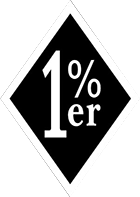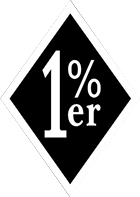In The Beginning…
As with other cities of the swinging sixties Glasgow had its share of newly opened clubs and coffee bars in the Hillhead area of the city and in Kings Road and Byres Road, which was the happening scene of the era. There was a particular coffee bar and an offshoot in Ashton Road called the Papingo, which had over its door arch a sign labelled; coffee and jazz. One of the Papingo’s many attractions was its late hours which appealed to the beatniks, artists and rockers who populated the Hillhead districts.
Within the rocker element a group of like minded guys got together and decided that a change of image from the Brandon Boys of the rockers was called for. Only a name was required and they all agreed on the name; “THE BLUE ANGELS”, for various reasons.
Allan Morrison and Lenny Reynolds thought this was quite apt, because blue was Scotland’s national colour. Tommy Howells had then worked out the letters of blue stood for Bastards, Lunatics, Undesirables and Eccentrics – of which he said, just about summed up the Blue Angels!
Over a period of time the image attracted others who liked the Sunday runs, of which the Blue Angels organised to race on the hill roads around Glasgow. Then also every so often, trips into the Western Highlands which were quite near the city. It was also round about this time that the mod gang culture was starting to take off and gangs like the Maryhill Fleet, the Calton Tongs, the Townhead Shamrock, the Gorbals Cumbie, the Govan Team, the Drumchapel Buck, the Pollok Bundie and the Partick Cross Boys. Were starting to carve out their territory, quite literally. While other gangs and sub gangs would proliferate the big boys who would go on to organise protection rackets shebeens, (illegal drinking dens) and some even prostitution.

Billy Gordon (Stone) – Founder, Blue Angels MC – 1963

Allan Morrison – Founder, Blue Angels MC – 1963
The Phenomenon
The phenomenon had always existed in Glasgow but this time the gangs did not spawn from poverty, but from the pull of getting a share of the large amounts of money which were floating about in Glasgow. The different cultures would soon clash and while the top of Byres Road was accepted Fleet turf, and the bottom was indeed Partick Cross, and was the turf of the gang of the same name. The middle was accepted as neutral and the styles and fashions on the whole mixed in harmony.
but from the pull of getting a share of the large amounts of money which were floating about in Glasgow. The different cultures would soon clash and while the top of Byres Road was accepted Fleet turf, and the bottom was indeed Partick Cross, and was the turf of the gang of the same name. The middle was accepted as neutral and the styles and fashions on the whole mixed in harmony.
However, one night the Blue Angels were drinking in the “Curlers Tavern” which was exactly in the middle of Byres Road and was one of the first places for the drug culture to blossom, which made for good nights and great parties! It was the place to be when a crowd of suits came in. As the time went on dirty looks started and the insults followed, soon a bar brawl of John Wayne style proportions began – which spilled out from the bar onto the street.
The suits ran in, slashing with their razors and the Blue Angels retaliated with flick knives, switch blades and tyre levers; there was bawling and shouting, guys were slashed and stabbed and several guys collapsed with weapon wounds.
Soon the police arrived in droves and waded into all and sundry making no distinctions, some were captured and some got away. Many of the Blue Angels were incensed and what was to become a pillar of policy “retaliation, out of proportion” followed in the weeks to come, with cafes and bars petrol bombed and sneak attacks done in the night by both sides. Soon wiser heads decided that guys getting injured and imprisoned was not conducive to a good lifestyle, and soon talks took place to end the strife. By the end of the night drinks were exchanged and many of the suits were introduced to the joys cannabis resin! Promises were made to help fix cars and scooters, while individual fights would break out over the period, the two gangs held each other in mutual respect, and never carried out hostilities against each other again.
The Blue Angels were Glasgow’s premier because of the reputation they had built in the war with the Maryhill Fleet and whilst some like Lenny Reynolds were slashed and stabbed in a very short period, this did not detract from the style of the bikes. The image and the penchant for violence which saw the Garthamlock Blackhawks join with the Blue Angels and later some of the Roadburners.
After a battle in an Asian Restaurant the nickname “The Blue Gang” became prevalent and the walls of Glasgow and its outskirt towns began to see alongside local gang graffiti, slogans such as Blue Angels OK, Blue Angels, Best in the west. The slogans started to appear on the hill roads, on mountain passes and as the Blue Gang travelled the slogans appeared in places like the Ace Cafe, the Busy Bee, various truck stops and transport cafes and further afield like the Eiffel Tower and the Necropolis in Athens. The American magazine; Saturday Evening Post, arrived in the middle sixties with an article on California’s Hell’s Angels and the sleeves were cut off the Wranglers. A new style of bike was appearing after the Blue Gang viewed Peter Fonda and Bruce Dern in “The Wild Angels”, the Chopper!
Custom Bikes & Colours
Custom bikes became the thing but most of all, insignia called colours, adapted from the Americans were designed. Rather than adopt the American concept in full – which had the club name at the top, insignia in the middle and place name at the bottom. The Blue Angels being conscious that the terrain they moved in was much smaller than California and that their membership did not come from one area.
Plus, the pride of the founder members in their gang background displaced with the place name and instead, had Blue at the top in a mixture of gothic and Celtic lettering. Shown in the middle was a skull copied from the Waffen-SS with a German helmet from the despatch riders of the same formation. On each side of this, yellow wings spread in homage of the symbol of angels; the powerful wings of flight symbolising freedom, and the bottom displaying the word Angels.

Original Colours 1963
Design
This design was unique then and even today there are not many similar designs throughout the biking world, such is the pride of the insignia, the Blue Angels copyrighted these colours in 1997. Most of our runs were to England where it was warmer. We met bikers from England and they became the Sheffield chapter and Leeds chapter. We started a chapter in London with Igor and friends but we didn’t give it enough support and they broke up. We also made friends with the Road Rats London, who were tuned into our wavelength.

Blue Angels Glasgow – 1963
The travelling would go on, time would go on, some died, but fresh blood would replace them, more wars came, biker wars this time. As savage as biker wars are, but yesterday’s enemies are today’s friends and yesterday’s foe’s look down their noses at the new kids on the block. Who don’t have the wounds and scar tissue, or the traditions of the old combatants. The reputation and the history has spread from Frisco Bay to Sydney Harbour, 28 have died for and because of the lifestyle including one on a life sentence, all on behalf and for the Blue Angels.
Names of the legends are spoke of with reverence, Billy Rolling Stone, Sammy the Fox, Shannie, Nasty Bob, Mad Fitsy, Big John Herne, Danny The Fish, Scoobie, Chaza, Bunker The Coalman and Bugsy. The talk of the dead and what they done creates today’s pride, brotherhood and loyalty and the men today know what is expected of them.
The Blue Angels are the oldest outlaw bike gang in Europe, established in 1963 and getting stronger day by day.
(Original content written by Lenny Reynolds – still active, original 1963 member of Glasgow Mother Chapter)



